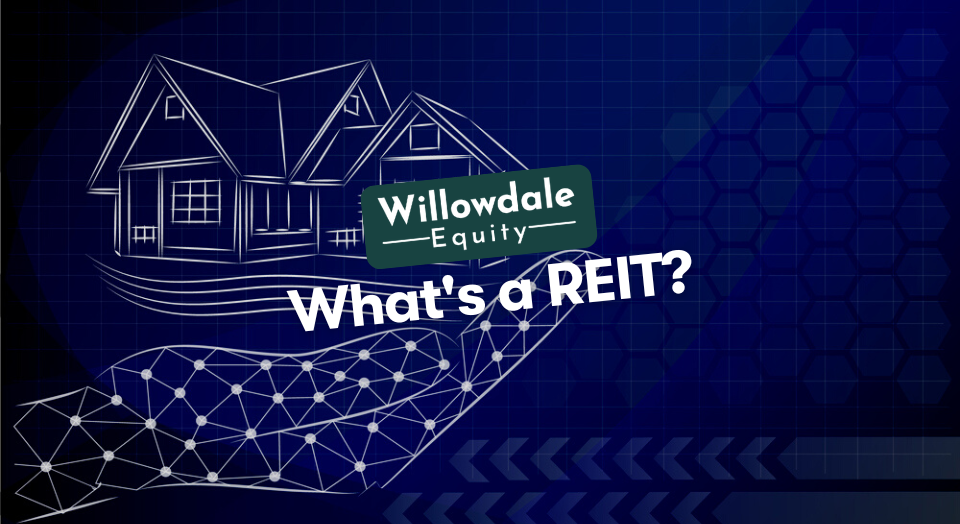
What’s a REIT?: Everything You Need to Know About Real Estate Investment Trusts
This article is part of our passive investors guide on real estate syndications, available here.
Real estate investments have been a way to build wealth and generate passive income for decades. Well-managed income-producing real estate investment can generate a generous monthly rental income and subsequent return on investment.
Many people think real estate investments only involve buying land or rental property. However, these investments aren’t accessible to everyone since they mainly involve large capital upfront. So, what’s the option for interested investors who may not afford the substantial upfront cost?
This is where REITs come in. These investments help investors enter the real estate market without buying and maintaining rental property.
In today’s article, we’ll discuss REITs, what they are, and why you should consider them as part of your portfolio.
Key Takeaways
-
A Real Estate Investment Trust (REIT) is synonymous with mutual funds allowing investors to invest in real estate without buying and managing rental properties. It’s a security company that buys, manages, rents, and sells real estate.
-
REITs invest in residential properties, retail properties, and office properties to name a few.
-
REITs can be divided into two main categories based on their investment. The two main categories are Equity and Mortgage REITs.
What's a REIT (Real Estate Investment Trust)?
A Real Estate Investment Trust (REIT) is synonymous with mutual funds allowing investors to invest in real estate without buying and managing rental properties. It’s a security company that buys, manages, rents, and sells real estate.
When you invest in a REIT, you’re buying a share of the real estate in the company’s portfolio. Many publicly traded REITs offer high yields since investors also get a share of the trust’s profits. But where do REITs get their profits from?
REITs generate money through the mortgages used to obtain real estate investments or the rental income from rental properties. Every shareholder in the REIT gets a consistent income. If they hold the portfolio long enough, the shareholders enjoy the property appreciation.
The best thing about REITs is that they generate passive income. You don’t have to worry about anything associated with the investments, management of the properties, or attend the deal closings. Anyone, whether a newbie or an experienced real estate investor, can buy shares in a REIT.
Although more sophisticated or seasoned investors who want a more passive approach would likely opt to invest in a private real estate syndication. Syndications offer investors potentially higher yields and direct tax advantages, which you don’t get access to by investing in a REIT.
What Properties do REITs Invest in?

Now that we’ve looked at what REITs are and how they generate income, you might wonder what kind of properties they invest in. Here’s a list of a few common income-generating properties that REITs invest in:
- Residential properties
- Retail properties
- Office properties
- Healthcare
Let’s look at each type of property individually to understand the types of REITs better.
Residential Properties
Residential REITs invest in and manage residential properties, such as single-family rentals, multifamily apartment complexes, and manufactured properties. The value of such a REIT fluctuates depending on the housing demand in the real estate market.
These types of REITs tend to be recession-resistant. This is because housing is still a priority to many people even as the cost of living rises. People would rather cut other items from their budget, with housing being the last item to cut back on.
There are a few factors to consider before investing in residential REITs. For example, the best residential rental markets are where there’s low affordability for housing. Large and profitable REITs tend to focus on large housing markets, such as New York and Los Angeles, where the high cost of housing compels many residents to rent. This boosts the demand for rental properties, allowing landlords to charge higher rates.
Investors who invest directly in rental properties tend to look at a few economic indicators, such as job growth and unemployment rates. A growing population also indicates readily available jobs and a stable economy. All these indicators are a sign that vacancy rates will lower and demand for housing will grow.
Once you’re done looking at the market-level factors, it’s time to look at the REIT itself. You want to invest in a well-managed and transparent REIT with balanced books.
If the REIT is well-managed, it’ll take advantage of economic downturns and purchase properties at distressed prices. This is the kind of residential REIT you want to invest in.
Retail Properties
Did you know that 24% of all REITs in America are in retail properties and shopping malls? This makes retail REITs the largest category of REITs in America. So huge is it that chances are that a REIT probably owns the shopping mall you frequent.
Like investing in residential REITs, you must consider a few factors before investing in a retail REIT. You must consider the retail industry’s financial health and the future’s general prediction.
Remember that investors in a REIT make an income from the profits generated from the REIT’s portfolio. Retail tenants going through cash flow problems will struggle to pay the rent and eventually shut their operations down. As such, you must invest in retail REITs with strong anchor tenants. Strong anchor tenants include outlets that deal with groceries or home improvement.
Don’t forget to check the company’s balance sheets and capital availability.
Office Properties
As you can already guess, office REITs invest in office properties. These REITs receive rental payments from commercial real estate tenants who sign long-term lease agreements. Here are a few questions to guide you if you’re interested in investing in an office REIT?
- What is the level of unemployment in the market?
- What does the economy look like?
- What is the level of vacancy rates?
- How are office REITs doing in that market?
- How much capital is accessible to the REIT?
One secret with office REITs is finding one that invests in economic hubs. It’s better to invest in a REIT that owns several average office buildings in New York than one with a primary office property in a slower market.
Healthcare
Healthcare REITs invest in real estate, such as medical facilities, hospitals, retirement homes, and nursing centers. The success of these kinds of REITs depends on the performance of the healthcare system. If the healthcare sector isn’t well-funded, these REITs will struggle to make profits.
Vital factors to consider when it comes to healthcare REITs include diverse groups of customers and investments in various property types. While majoring in one group of customers or property types is good, you don’t want to put all your eggs in one basket. It’s essential to spread your risk.
In addition, look for healthcare REITs with great experience in the healthcare sector. Don’t forget to check the balance sheets and access to capital.
How does a Business Qualify as REIT?
If you’re wondering what it takes for a company to become a REIT, here’s a breakdown of the process:
- At least 75% of the company’s total assets must be invested in real estate
- The company must generate at least 75% of its gross income from sales of properties, rents from rental property, or interest from property mortgages
- Be taxable as a corporation
- Pay at least 90% of its taxable income as investors’ dividends annually
- Have a board of trustees or directors
- Have a minimum of 100 investors
- No more than 50% of the shares should be held by five or fewer investors
Which Types of REIT Invests Directly in Properties?

REITs can be divided into two main categories based on their investment. The two main categories are Equity and Mortgage REITs:
- Equity REITs: These are the REITs that invest directly in properties that generate rental income. Most popular REITs today are publicly traded equity REITs. These REITs simply generate income from renting their properties to tenants. Once they’ve collected their revenue and paid for all expenses, they pay out dividends to the investors annually.
- Mortgage REITs: These REITs get their revenue from interest on mortgages. These real estate companies are becoming popular since they have a high-interest rate on commercial mortgages. Commercial property mortgages have higher interest rates since they are riskier than residential real estate. This means that a shareholder in a commercial mortgage REIT will earn a higher dividend payout than an investor in a residential mortgage REIT.
While these two are the main types of REITs, there are also hybrid REITs that invest in both properties and mortgages. Investors in these REITs get more diversity and better protection from fluctuations in the housing market.
Hybrid REITs are suitable if you’re looking for both income and growth-oriented investments.
REIT Investing & Passive Income
As we mentioned before, investing in REITs is a great way to generate passive income. Once you’ve invested in one, you don’t have to worry about managing the properties, finding tenants, collecting rent, or handling maintenance requests.
Once the REIT has collected its revenue, it pays out annual dividend payments to its investors. We’ve seen that the amount paid to shareholders must be at least 90% of the company’s taxable income. This amount must be distributed among the investors.
How does a REIT Profit?
REITs revenues and profits are easy to understand. These companies generate income by leasing or renting real estate properties. The income is then paid out to the investors as dividends.
While it’s a requirement for REITs to pay out at least 90% of the taxable income as dividends, some payout 100%. The investors then pay the income tax on the dividends.
Frequently Asked Questions About Whats REIT
REITs are passive investments since they pay annual dividends to the shareholders. They have boards of directors or trustees who oversee the general management of the REITs, as well as run the investments.
The three basic types of REITs are Equity REITs, Mortgage REITs, and Hybrid REITs.
What's a REIT - Conclusion
REITs are a great investment option for people looking to invest in real estate without worrying about buying properties, managing them, and handling tenants. They provide a more liquid investment option and a steady flow of income. REITs can help you create a hedge against inflation and market volatility.
If you are interested in passively investing in value-add multifamily real estate, with direct ownership and access to all the tax benefits of multifamily, unlike a REIT? Then join the investor club here at Willowdale Equity, where you can access private multifamily real estate syndications of exclusive deals across the southeastern United States.
Sources:
- Rocket Mortgage, “What Is a REIT (Real Estate Investment Trust) and Should You Invest In One?“
- Reit.com, “What’s a REIT (Real Estate Investment Trust)“
- Investopedia, “5 Types of REITs and How to Invest in Them“
Interested In Learning More About PASSIVE Real Estate Investing In Multifamily Properties?
Get Access to the FREE 5 Day PASSIVE Real Estate Investing Crash Course.
In this video crash course, you’ll learn everything you need to know from A to Z
about passive investing in multifamily real estate.
We’ll cover topics like earned income vs passive income, the tax advantages, why multifamily, inflation, how syndications work, and much much more!




